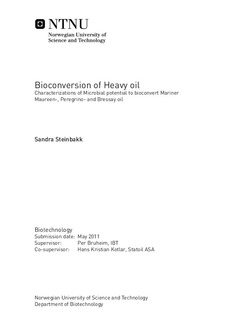Bioconversion of Heavy oil: Characterizations of Microbial potential to bioconvert Mariner Maureen-, Peregrino- and Bressay oil
Master thesis
Permanent lenke
http://hdl.handle.net/11250/245665Utgivelsesdato
2011Metadata
Vis full innførselSamlinger
Sammendrag
70 % of world s oil reservoirs consist of heavy oil, and as the supply of conventional oil decreases, researchers are searching for new technologies to explore and enhance heavy oil recovery. One of the postulated technologies is microbial enhanced oil recovery (MEOR), which is predicted to be a more environmental and economical process for improving oil recovery of heavy oil. The aim of this Master s project was to give a qualitative indication of three selected consortia s potential to bioconvert Mariner Maureen-, Peregrino- and Bressay oil. The consortia are comprised of microorganisms isolated from oil sand, mud volcano, processing waters from water treatment plants and oil related samples from other locations. Bioconversion experiments were conducted by inoculating the three selected oils with three consortia. Two terms of different main experimental designs was used; optimal growth temperature of the consortia or the temperature at reservoir conditions, in addition to cultivation with two different growth mediums. After cultivating aerobically for seven days, the oil was separated from the water phase and analyzed by thin-layer chromatography with flame ionization detection (TLC-FID) to identify possible indication of bioconversion. The results demonstrate a reduction in either one or both saturated hydrocarbons and aromatic hydrocarbons of the oil in several of the oil samples. DNA extracted from the water phase that was analyzed with denaturing gradient gel electrophoresis (DGGE), showed several positive results with indication of high biodiversity. The overall results indicate that there has been a microbial impact on some of the heavy oil fractions in Mariner Maureen-, Peregrino- and Bressay oil. Additional experiments must be done to identify the specific changes in the oil and prove microbial impact by repeating these experiments. This could potentially lead to identification of microorganisms with the ability to bioconvert heavy oil and the development of MEOR processes.
